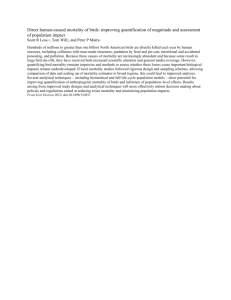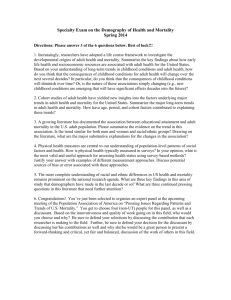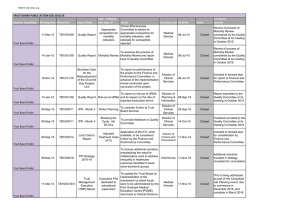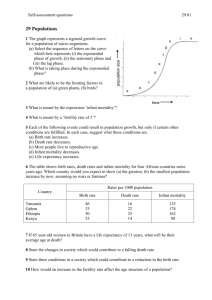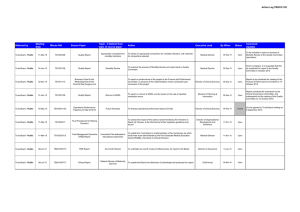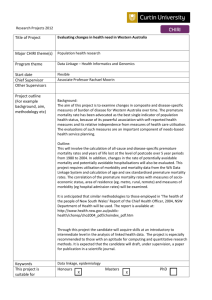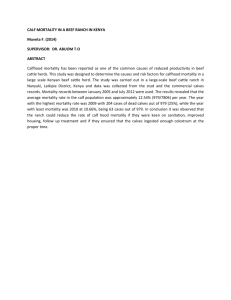Document 12786992
advertisement
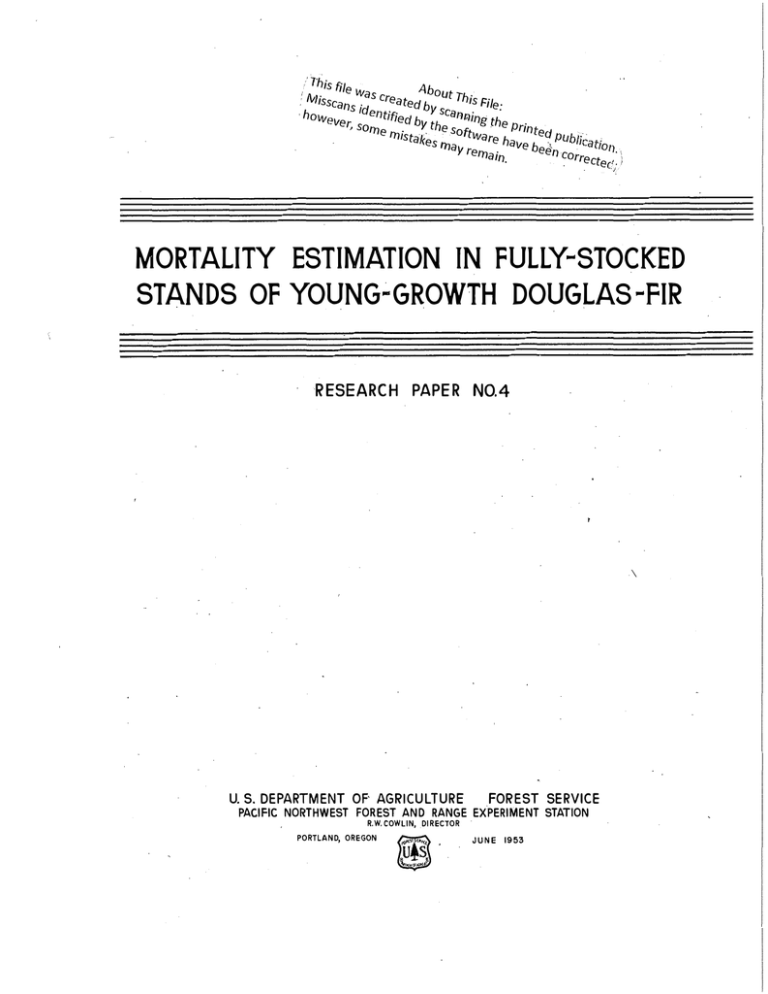
. file Ab wa s c out h reat d r is File: I l'vlis sc e by an s 'd scah . ' ent ·.c·ed howev ''' bY t ,-,t Jng th e er, s he s r; ame Printe twar mist ak e h av P U b licati es rn e be a r on en c ema in orrect ec: \1 . 'This · . · · . MORTALITY ESTIMATION IN FULLY-STOCKED STANDS OF YOUNG·GROWTH DOUGLAS-FIR RESEARCH PAPER N0.4 \ FOREST SERVICE U.S. DEPARTMENT OF AGRICULTURE PACIFIC NORTHWEST FOREST AND RANGE EXPERIMENT STATION R.W. COW LIN, DIRECTOR PORTLAND, OREGON JUNE 1953 MORTALITY ESTJMA.TION lli FU LLY STOCKED STANOO OF YOUNG-GROWTH DOU GLAS-FIR By George R, Staebler Puget Sound Research Center \ U S, Department of Agriculture Forest Service Pacific Northwest Forest and Range Exper:iment Station Portland, Oregon June 1953 MORTALITY ESTINIATION IN FULLY STOCKED STANDS OF YOUNG-GROWTH DOUGLAS-FIR By George R. Staebler Puget Sound Research Center Mortality is an important element in the history of even-aged stands, yet in young-growth Douglas-fir little information exists on the amount of loss or how it varies from stand to stand, Most of our knowledge of stand development is pieced together from single observa­ tions made on sample plots--yield tables, of course, are the classic examples, Unlike growth, mortality does not write its history in standing trees and therefore cannot be assessed in a single observa­ tion, The accumulated experience on permanent sample plots of the Pacific Northwest Forest and Range Experiment Station does, however, yield some of the needed information. This article presents results of a first analysis of the mortality on permanent sample plots, Mortality offsets much of the gross growth in even-aged, fully 'stocked stands of Douglas-fir, Knowledge of mortality is essential if one is to understand the silviculture of such stands and is probably of nearly equal importance in management planning. The permanent sample plots in the region have lost an average of 83 cubic f et per , acre pe r year in mortality g ing th e years of observation. l/ Gross growth may exceed net growt by anywhere from 15 to 40 percent, \the difference being the volume of the trees that died, Hence, mortality must be accounted for when net growth is estimated from gross growth. Since it is possible to predict gross growth with considerable accu­ racy, notably by stand pro jection, it is desirable to have equally accurate predicti ons 'of mortality for the computation of net growth, y Johnson, Floyd A. Mortality in · even-aged stands of young-growth Douglas-fir as observed on permanent sample plots, Manuscript report, Pacific Northwest Forest and Range Experiment Station, §./ Net growth, as here used, means the increment on trees surviving the growth period, without any deduction for cull increment. ___ 7 A scheme for predicting mortality should allow for variations in the forest stand so that the predicted losses will apply to specific stands, just as do increment core data. Such a scheme would permit construction of a 11mortality stand table J n that is the number of trees by diameter class expected to die in a given period. By subtracting these trees from the present or gross stand table, a net stand table can be readily constructed showing the number of trees expected to live through the forecast period. This net stand.could then be projected, using stand projection methods, to detennine net growth. Thus, the mortality estimation techniques described here, although they have many other uses, are primarily designed to enhance the accuracy of net growth presented predictions made by stand projection methods., The equations · permit a determination of the number of trees b y diameter class expected to die in 10 years for stands of different ages and sites. The equations are from an analysis of 36 sample plots widely scat­ tered in the Douglas-fir type of western Washington and Oregon. Some plots have been observed as long as 35 years, and for all plots together, the experience totals 770 yearsc The plots cover 32.13 acres and are located in even-aged, well stocked stands ranging in age from 26 to 93 years. Site indexes range from llO to 200, but the lower sites are rather poorly represented. Although mortality is an erratic phenomenon that can never be predicted exactly, particularly for small areas, the permanent srunple plot experience does indicate that mortality is related to some. easily measured variables, permitting fair predictions for periods as long as 10 yearso CHARACTERISTICS OF MORTALITY Natural mortality is generally divided into two categories (1) that which results from the normal decrease in number of trees as stands grow older, a necessary result of the f act that as t rees grow larger they require more growing space; (2) infrequent, sporadic losses //, due to fire, insects 9 disease9 or climatic extremes_. which cause \a.bnorma.lly high mortality in short; periods. The second type, which might be V called 11irregular1 mortality,. probably can never be satisfactorily fore­ -cast. _The first_ type 9 however, is more regular in occurrence and probably follows some natural laws, permitting reasonably good predic­ tions, The plots were separated into the two classes of mortality by arbitrarily saying that irregular mortality had occurred on those plots where losses were so great that they would not be expected to occur oftener than one decade in 100 years., This segregation was accomplished by a · statistical analysis of the per-acre per-decade losses in basal area on the plots to be used in the analysis0 , Five observations out of 77 were eliminated by this method. Mortality, in basal area, on these . five plots ·was about seven times the predicted 11 regularn losses for the same plots. This cannot be considered an adequate sample of irregular mortality, but does, perhaps, indicate the magnitude of such losses · It suggests, ·too the need for study of frequency and amount of this type of mortality The analysis of mortality explained in the following sections is bas d on 72 observations (of lO years2 losses) on 34 plots and, presum ably, represents only regular losses • . / FACTORS RELATED TO MORTALITY AND MORTALITY EQUATIONS Mortality, as used in this analysis, is the number of trees dying during a 10-year period expressed as a percentage of the trees alive at the beginning of the period. For each plot the trees in each crown class were grouped by 2-inch diruneter breast high classes, and the per­ centage of trees dying in each group determined. Age stocking, and site index on each plot were known. A multiple linear regression was run for each crown class, correlating percent mortality with d,b,h., age of stand, stocking, and site index. The resulting regression coefficients and the ir errors were studied and only the most important variables retained for the final mortality equations. This study showed that dominant and codominant crown classes could logically be combined, Intermediate and suppressed crown classes were also enough alike in their mortality habits to be combined, Equations for predicting the percentage of ·trees that will die in the next 10 years are: For dominant and codominant trees ­ Percent mortality= 4.96 + o08(age) - .4l(d,b,h,). For intermediate and suppressed trees ­ Percent mortality= -13,01 + .5 4(site index) + ,61 (age) - 7983(d,b,h,) For the first equation, the coefficient of multiple correlation percent of trees lost and the variables measured, R, equals betwe .266.2! The correlation, though low, is not due to chance, and use of Precise the equation will give better results than a simple average. estimation of mortality in the dominant-codominant trees is obviously difficult. These trees die as a result of any of a host of causes ­ including insect damage, root rot, and windthrow. These things occur haphazardly in a stand and sporadically over the years, even when not in sufficient proportions to classify the mortality as irregular. Such loss usually has little relation to any easily recognized characteristic of the tree, The equation shows that mortality in the domin nt-codominant stand increased as the stand grew older, ·and smaller trees in the class were The difference in mortality more likely to die than the larger ones. stands on different sites was so small that it could be ignored, between 2/ In interpreting the correlation coefficients, it is assumed that the o bservations are independent even thougl:. they do not come from ran­ domly located plots. The considerable variation bet·ween plots and between successive lO year losses on the same plot indicates that the assumption is justified. 7 £/'/ Correlation for the second equation, that is, for intermediate and suppressed trees, is much higher: R = • 71.5; Apparently, mortality in Besides age and d. b.h. these crown classes is much more consistento site influenced mortality significantly, the percentage of trees dying being greater on higher sites. It is likely that the faster growth of individual trees on the better sites results in more rapid suppression of less vigorous trees and consequently higher mortality" Stocking of the stand.., for both equations, had little effect. The permanent sample plots from which the data were taken had only a small v· range in stocking since most of the plots had been deliberately picked to represent fully stocked stands. Hence.., the effect of stocking on mortality was not shown by this analysis. It seems logical, howev.er, that separating the da·t;a into dominant and suppressed components of the stand will automatically allow for changes in s·tocking. That is, in a medium or poorly stocked st nd few. trees would be cls.ssed as intermedi;_ ate or suppressed. Low mortality, then would be predicted according to the dominant-codominant equation., In better stocked stands more tree13 would fa:ll into :the higher risk intermed . iate and suppressed classifica..:. tions. Although the present study gives no indication that predictions can be accurately made in understocked stands p the equations will perhaps · suffice until such ·sta:nds can be adequateJ.:y- studied · · · · · · . .. MORTALITY TABOO AND THEIR USE For convenience, the morta.lity equations have been solved and These tables . show the percent­ written in tabular form· (tables l and 2)0 age of trees in d.boho class expected to die in 10 years by selected 'ages of the dominant-codominant stand9 e.nd. by selected ages and site classes for the intermediate-sv,ppressed part of the stand. Mortality percentages for in-betweEm values of the independent variables may 'Qe obtained by interpolErtion or by solution of the original equations. To predict the mortality in a stand; it is necessary to have stand table showing the nlimber of trees by d.b. h. class for the dominant• oodominant and for the intermediate-suppressed components of the stand., The age of the. stand and the site index must also he known. The number. of trees is multiplied by the appropriate. percentage of trees expected to . The result die, as read from the tables or computed from the equations is a stand table of expected mortality 11 which can be converted to volumes as desired by using local volume tables Subtracting ·the trees expected to die will give a net stand table· from which net growth may be computed· by stand projection. Getting crovm-class information will usually entail extra work. Cruise data even in intensive surveys, seldom show crown class. The · ' percentage of trees in each crown class for each dD bcho Class may be· determined from a· small number of sample plots and ·then applied to the total stand table The two needed stand tables may be made up by this methodQ An alternative method would· be to compute a·. single mortality percentage for each d. b h. class by weighting the tabular mortality· ·values by the percentage of trees in the dominant,.;,codominant and intermediate=suppressed classifications., 1. v/ Separation into crown classes ·in the field should be acMfd).ng ·to the standard definitions given in most silviculture textbooks .btl . For rough calculations or where tinie does no·t permit getting accu"" rate crown class informationp the stand may be broken into the two i no U sually 9 inspec­ c mpo n nts e: t a giveri ob.h o after .careful observat o k 1 to say that mos t o f . t he trees be 1ow some. t on Wl 11 ma e it posslb e diameter limit are intermediates and suppressed; above that diameter the majority are dominants and codominants. The required site index and age of the stand are usually determined as part of a routine stand examination. A mortality ste.nd table for intermediate and suppressed ·trees.P pre• pared. from table 2$ can also aid a forest manager in planning a thinning from .:elow. In making a low thinning the trees expected to die in the lower crown classes are cut. A mortality stand table would give an idea of the number, distributio:n9 and volume of trees that might be removed in a cut to be repeated at lO=year intervals. · A sp.mple calculation of mortality on the Voight Creek Experimental 5 is shown in table 3e The steps required and the methods are ForesW largely sel.f'-.explanatoryo In this stand ·the expected mortality for 10 years is 324.9 cubic fee·b p( r acre in 55 .. 0 trees,. or 32-5 cubic feet per acre per year. Seventy-seven percent of this expected loss will probably be in 6-and 8=inch trees · STfMVIARY Mortality in forest gi, mds, being an erra,t:ic phenomenon, is v ry difficult to predict 9 particularly for a specific s·tandc A predicition is needed for such stands however, in order to forecast net growth by stand projection methodso Information from permanent sample plots has yielded some .first approximations to the solution of the problem for young\..growth Douglas-firQ It was found that regular mor·te.lity s> which excludes excessive. losses can be predicted with considerable success. Irregula1 :losses must be accounted for independently ·probably b y some risk allow­ ance, until better information is available. The present data are not extensive enough 'to provide even e.n.e..verage figure for such losses., · Regular mortality 9 taken as the per .centage of .t rees ·that die in 10 years 9 was found to be correlated to age of the stand and d .. b.ho of the trees for the dominant codomine..nt component of the stand, and to site index, age9 and d.b .h., for the intermediate-suppressed component. Although thE! data are from f'ully stocked stands 9 the mortality equations are believed to be at least reasonably adequate for medium and poorly stocked standsp and should prove useful until better infonne..tion is available<> --------�--�--���-----�----� -------- See Hawley 1 The Pre..ct·ice of Silvicuiture" 4th Ed.9 1937'9 p 158, or Baker, 1''l'heory and Prac·Gice of Silviculture' 1st Ed.,., 1934, P• 258:­ Maintained by the Pacific Northwest Forest .and Range Experiment Station in coopera.·tion with the St .. Paul and Tacoma Lumber C ompany. . / The equations per.mit calculation of an expected mortality stand table that can be converted to volumes as desired by using local volume tables0 Net stand tables, showing the number of trees by d0b0h0 expected to live through the forecast period9 can then be projected forward for the calculation of net growth0 Table lo--Percent of dominant and codomi s in ful stoct�d sta ds expected to die in l2_Y-earso age of stand.and deboho of trees �E::J:o: ::r: : 4o CJ.:o A ge - ' I :: :0= I : : ]§ Inches _, [ . ci._<J 9<C: -Percent­ 6 8 10 4.9 4ol 3o3 5o7 4o9 4.1 6o5 5o7 4.9 12 14 16 18 20 2.11106 .8 3 .. 2 2 .4 106 .8 4.o 3 2 2u 4 1.6 22 24 26 28 30 .s 6o5 5o7 7o3 6.5 801 7.3 8. 1 4. 8 4 oO 3.2 2.1). 1.6 5 .. 6 4. 8 4 .0 3.2 2. 4 6JJ. 5o6 4. 8 4.o 3.2 7o2 6oh 5 .6 4o 8 4 .0 .7 1.5 .7 2o3 1.5 o7 3ol 2 o3 1.5 o7 ..;. - Computed from eque. tion: R = .266 Percent = 4.96 + o08 (age) = oltl (d obohc) \ /) Table 2c= Percent of intermediate and SUEEressed trees .!!.:, 11 < tQQ� !l stands· ex:eected to die in nd d. b. h. 10 ears,e bz site 2 age pf s. E. of trees D:b -h:J-;::: I : : o: : Inches D = - - - A := r: : 70 : : 5 o: I = = c: bO = Site II 2 4 6 8 10 12 14 16 81 66 50 34 88 72 56 41 25 -Percent= (s .I 78 62 47 31 15 o = 68 53 37 21 6 12 14 65 50 34 _ .., _,;iQ """" 71 56 40 24 9 ... Site IV 2· 4 6 8 10 12 49 33 .., ... 55 39 24. ., - = - - - - - 81 65 49 34 18 2 71 55 40 24 8 "" 74 58 43 27 11 80 64 49 33 17 2 71 55 8 \ (s.r. =no) """" 61 46 30 14 ...... 52 36 20 5 _,. 58 42 26 11 ""= _.;.. 64 48 33 17­ 12 70 54 39 23 7 --- Computed from equationg R = - 140) '*= -- - : [3o:-- @ 170) "'"" 84 68 52 37 21 5 77. 62 46 30 . 15 = 75 59 43 28 12 Site III (S 2 4 6 8 10 = [ Percent ==13o01 OP 715 =7= + o= 54(SI) + .61(age) 7o83 (dob oho) 0 Q Q 0 Table 3. -sample calculation of 10- year mortalit for o ye.ar old, site III stand on .Voight Creek Experimental F orest Mortality percent Calculated mortality Present stand Trees Total volume Net D,b,h, Number stand I&S Wgted dying mortality D&C trees D&C I&S ( 5) (6) (7) (3). (4) (10) (9) (1) (8) (2) Number cu.ft. Number Pet, Pet, Pet, Pet., Pet In, 6 8 10. 140 79 58 25 77 95 75 23 12 14 16 18 20 23 13 4 2 1 98 100 100 100 100 2 22 1 100 Totals 321 - 5 - ­ - ­ 5.7 4o.o 31.4 4. 9 24.4 4.1 8,7 9 4 4.3 3 2 2o4 1.;6 . .8 3.1 2,4 1.6 .8 - = - - - - - - 44 0 7.4 2.5 on .3 ,1 180.4 69.6 L lc5 55.5 17.6 10,9 4.9 22,3 12o7 3 9 2 0 1.0 - ... - - - - - - - - - - 55.0 96 0 71.6 3 24o9 l O 266,0 Annual loss Explanation: Col. 1 2 3&4 5&6 7 - 8 9. 10 Present d b,ho from cruise --stand per acre from crown class sample made during cruise \ computed from mortality equations (col. 3 x colo 5) + (col, 4 x c61, 6) 100 col. 7 x colo 2 computed from local volume table col. 2 - col, 8: stand to be projected for prediction of net growth
